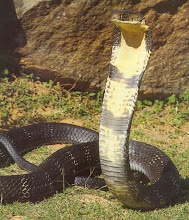When you enter a park, what do you see? Trees? Obviously. Mosquitoes? Lots of them. Maybe a few birds? Yes. Anything interesting? Not really.
Why not look up at a tree, like the one above, shot in West Coast Park? What do you see? Leaves? Duh. What else?
The sky... and... wait a minute... What is that thing in the middle of the picture?
Lets move to a different angle shall we?
The colour pattern is a complex geometric pattern that incorporates different colours. The back typically has a series of irregular diamond shapes which are flanked by smaller markings with light centers. In this species' wide range, much variation of size, colour, and markings commonly occurs.
In zoo exhibits the colour pattern may seem garish, but in a shadowy jungle environment amid fallen leaves and debris it allows them to virtually disappear. Called a disruptive colouration, it protects them from predators and helps them to catch their prey.
This nocturnal snake is both terrestrial and arboreal, catching small mammals and birds, and strangling them before swallowing them whole.
Reticulated Pythons can be found in most habitats from forest to mangroves, and often near human habitation.
They are capable of overpowering a person, so my advice to you is not to go near one if you ever meet one.

No comments:
Post a Comment